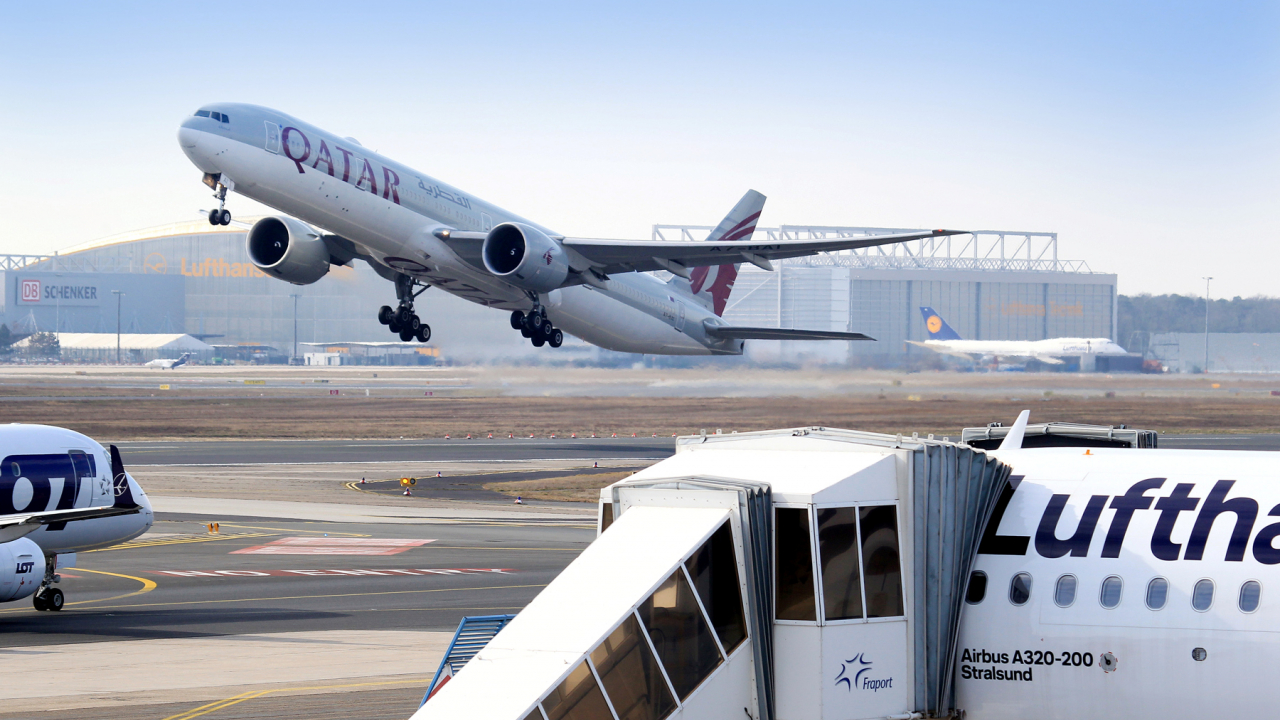Air Travel Demand is Surging While Macroeconomic Risks Remain. Where Does That Leave Us?
Kevin Rozario
March 1, 2023

Qatar jet taking off at Frankfurt Airport.
© Fraport
Airports Council International (ACI) released its latest quarterly airport traffic outlook last week showing the positive demand for air travel in many markets despite macroeconomic risks from inflation, the war in Ukraine, high fuel prices, and supply chain disruptions continuing.
ACI World’s quarterly update was released in tandem with the trade association’s annual Airport Traffic Forecasts analysis which offers insights into the air traffic outlook to 2041. As if the current macro complexity wasn’t hard enough to decipher, ACI World has attempted to offer both short-term and long-term forecasts.
In the coming years, the association has laid out three scenarios for growth: base, optimistic, and pessimistic (see chart below). In every scenario, traffic will trail versus pre-COVID forecasts, but in the optimistic camp, global traffic should reach 2019 levels towards the end of this year or sometime in 2024.

Three scenarios for global passenger traffic growth (indexed, 2019 = 100)
Recovery In 2022 and the Short-Term
Some highlights from the 12th Advisory Bulletin on the impact of COVID19 on the airport business include the following:
-
The removal of travel restrictions and quarantine requirements for vaccinated travelers in 2022 has led to an uptick across many markets.
-
Global passenger traffic finished last year at 72% of 2019 levels or a total of 6.5 billion passengers.
-
Market segments vary markedly—international passenger numbers were only at 60% of 2019 levels whereas domestic numbers were at 79%.
-
The recovery in passenger volumes in 2022 was very uneven: Latin American and Caribbean markets reached 91% of 2019 levels (notably higher in Colombia) whereas Asia-Pacific lagged at 52%.
-
Global passenger traffic is forecast to reach 92% (or 8.4 billion passengers) of 2019 levels this year.
-
The baseline projections for global passenger traffic indicate that the industry will recover to 2019 levels by 2024, driven mainly by domestic travel.
ACI World’s Director General, Luis Felipe de Oliveira, commented: “The surge in travel following the lifting of restrictions in 2022 continues into 2023. We know from our Global Traveler Survey (covering 4,125 respondents across 30 countries) that 86% plan to travel by air in 2023—this is the highest intention to travel score since the beginning of the pandemic.”
But intention to travel and actually traveling are two different things. The director general added: “We are cognizant that the speed of the recovery depends on several factors. The possible slowing in GDP growth in major economies coupled with the rise in airfares due to higher jet fuel prices weigh negatively. On the other hand, a strong labor market and the re-opening of China—the second largest aviation market after the United States—represent important boosts to global passenger traffic.”
Forecasts Out to 2041
Looking further ahead, ACI’s Airport Traffic Forecasts 2022–2041 indicated the following:
-
Passenger traffic worldwide is expected to reach 19.3 billion in 2041.
-
In 2041, airports are predicted to handle almost 200 million tonnes of air cargo worldwide. The United States and China will remain the two largest markets, together accounting for 40% of global cargo.
-
Airports worldwide will see 154 million aircraft movements by then, led by the United States, China, and India. They will respectively, host 23%, 16%, and 4% of global aircraft movements.
ACI World’s flagship dataset presents 20-year traffic forecast figures so that airport planners and investors can make informed business decisions and develop data-driven strategies, the association says.
The forecasts pull data from over 110 countries covering short-, medium-, and long-term trends on total passengers (international and domestic), air cargo volumes, and aircraft movements. The data can be further segmented on a global, regional, and national level to gain as accurate a picture as possible.
